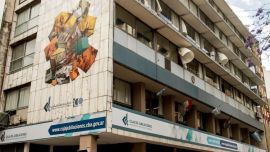On Wednesday, the 24 senators elected in eight districts in the October 27 elections were sworn into the seats they will be occupying through to 2025.
Key to the Peronist unification was the decision of the Frente para la Victoria (“Victory Front,” FpV) caucus – which responds to vice-president-elect Cristina Fernández de Kirchner – to switch its support from Mendoza Senator Anabel Fernández Sagasti to the more traditional Peronist Senator José Mayans from Formosa to head the new caucus. Fernández Sagasti is seen by some as too close to the ex-president.
“The caucus will be called Frente de Todos,” said Mayans last week. “Our numbers will be very important, we’ll be 41 senators [out of a total of 72] or almost two-thirds. We’ll have a quorum with a majority on all committees.”
Before the new senators took their oaths, the request of Tucumán Peronist Senator José Alperovich for a leave of absence without pay to answer charges of sex abuse was accepted. A power cut made the hour-long session overheated in meteorological terms but not otherwise.
Meanwhile, Fernández de Kirchner (president from 2007 to 2015) resigned the Buenos Aires Province Senate seat she won in 2017 and will be replaced by her former foreign minister Jorge Taiana. Senator Omar Perotti also needed replacing as the governor-elect of Santa Fe with provincial deputy Roberto Mirabella serving out his term.
“This caucus of 41 is a major achievement, it will give the president plenty of air. Cristina Kirchner adopted a broader outlook to assemble this Peronist caucus so that everybody could feel more comfortable in the Senate,” said Córdoba Senator Carlos Caserio, who previously headed the other main splinter, the Federal Peronist caucus. Caserio is regarded as a possible future minister in Alberto Fernández’s Cabinet.
As vice-president, Fernández de Kirchner will be heading the Senate with Santiago del Estero Senator and ex-governor Claudia Ledesma Abdala de Zamora immediately under her with the title of provisional president. Ledesma will be seconded by another ex-governor, Senator Maurice Closs of Misiones.
The role of opposition will fall to the 29-strong Juntos por el Cambio coalition (which went under the name of Cambiemos in the old Senate) responding to outgoing Presidente Mauricio Macri, with expresident Adolfo Rodríguez Saá (San Luis) and outgoing Río Negro Governor Alberto Weretilneck the only outsiders.
Curiously both the main groupings will be headed by senators from the small and remote province of Formosa, since Radical Luis Naidenoff will marshal the Juntos por el Cambio caucus.
Next Wednesday (December 4) it will be the turn of the 130 deputies elected on October 27 to be sworn in. The 257-seat Chamber of Deputies will be a different story with the Peronist caucus in second place to Juntos por el Cambio.
The eight districts to change their three senators this year were the Federal Capital and Entre Ríos, the three Patagonian provinces of Neuquén, Río Negro and Tierra del Fuego and the three northern provinces of Chaco, Salta and Santiago del Estero.
Of these 24 future senators, 15 are aligned with president-elect Alberto Fernández and eight with Macri (of whom only five originate from his coalition parties) with one independent. Only six of these future senators were defending seats. The best-known names are former economy minister Martín Lousteau and 2015 City mayoral runner-up Mariano Recalde in the Federal Capital. Ledesma, former AFI intelligence chief Oscar Parrilli and Weretilneck, the solitary independent – all the others form part of the Frente de Todos caucus except Lousteau.




















Comments